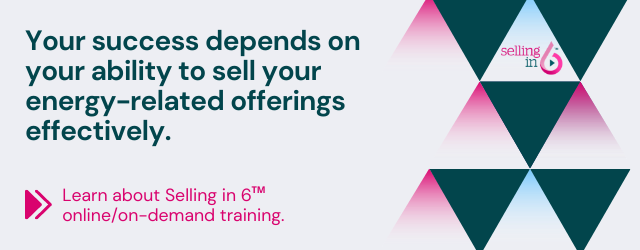Why might your prospect be willing to say “yes” to taking on a proposed energy solution? Is it about saving energy? Saving money? Saving carbon? Something else?

No doubt there are dozens of reasons a prospect might be motivated to say “yes” to pursuing your energy project. I encountered one of the more surprising ones a while back when a workshop participant told me that her municipal client agreed to do a project because if they hadn’t found something for one of their managers to work on, they would have had to lay him off. It wasn’t about saving the energy itself, the economic value nor the carbon content. It was all about saving their valued team member from the unemployment line.
I often reference Seth Godin’s “hierarchy of business needs.” Seth argues that if you’re selling a product or service to a non-business-owner in a B2B setting, the primary needs rank in the following order:
- Avoiding risk
- Avoiding hassle
- Gaining praise
- Gaining power
- Having fun
- Making a profit
How does the typical energy solution proposal fare when evaluated in the context of that hierarchy? Well, let’s think about it.
How much risk does a manager take on by saying “yes” to a 50+ page proposal written in a language that’s not his own (think “engineer-speak”)?
How much hassle is involved in understanding all of the potential competing technologies and approaches, interviewing and then selecting suppliers, negotiating contracts, applying for and securing the necessary capital, filling out incentive applications, cooperating with pre- and post-installation walk-throughs, measuring actual savings against projections, etc. – all for the purpose of replacing equipment that is not technically “broken”?
Skipping down to the bottom of Seth’s hierarchy, how might the resulting energy solution map into the last item: making a profit? How similar is “saving energy” to “making a profit”? And how much is the estimated savings? Would it even “move the needle” when compared with the rest of the organization’s overhead? Who would actually receive the savings? And would that be the same person who had to endure all the above-referenced risk and hassle?
Suppose your prospect is disengaged with his or her job, or even seeking a new employment opportunity. Can you imagine their perspective on taking on additional risk or hassle when, even if the project were successful, their “prize” would be their employer making more profit?
I mentioned all of this at one of our Boot Camps a couple years ago and someone wryly pointed out that the middle-ranked motivators – gaining praise, gaining power – still applied even if you were seeking other employment. Why? A successful energy project is a great resume builder! Reducing your present employer’s energy bills or capturing an ENERGY STAR® label for the facility you now manage could be a feather in your cap while interviewing for a new role.
One thing’s for sure whether your prospect is looking for another job or not. Someone who has the insight to connect the dots between enhanced energy efficiency and more traditional metrics of performance (think better productivity in office environments, lower scrap rate in industrial settings, better learning outcomes in schools, etc.) stands to receive praise and maybe even more power and influence within their organization by jumping on the efficiency agenda.
So, what are the morals to this story? I see at least three:
- Never assume the reason that your prospect is interested in your offerings is as simple as saving energy or even money.
- Realize that decision-makers are human beings first and job titles second.
- Leverage the above-referenced Seth Godin hierarchy as you formulate compelling value propositions for your prospects. How? Well, how about these for starters....
-
- Reduce the risk: Bring industry foreknowledge to the table – genuine insight into how your solution has provided value for others in your prospect’s situation and how your offerings compare to the competition’s. Doing so will reduce the perceived risk of whatever you are proposing and help the prospect feel more comfortable proceeding without undertaking extensive due diligence.
-
- Minimize the hassle: Make it easy to do business with you to reduce the perceived hassle factor. Act as a broker of strengths and coordinate your efforts with other vendors, if necessary.
-
- Offer promise of praise: Offer to write a success story – or perhaps help the prospect apply for the ENERGY STAR label – after the proposed project is successfully implemented.
-
- Draw a path to increased power: Help the prospect see how moving forward positions him/her more favorably in the organization. The above-referenced success story might also help the prospect justify a raise or promotion!
-
- Have fun: Wow, this point has so many dimensions, it deserves its own blog! Here’s just one to think about in the meantime: Make the effort to discover what the prospect finds truly fun and fascinating about his/her job, and then make sure your selling approach resonates with those preferences! Let’s say your prospect enjoys escaping the office for the occasional “field trip.” You might suggest a lunch at their favorite eatery bookended by two tours of visits to buildings already benefiting from your offering. Above all, be eternally positive and personable, have a great sense of humor, and use it often. By the way, if you don’t have a sense of humor, get one! Your prospects want to be around people who make them feel great!
- Demonstrate the true value: Take the time to connect the dots between your energy solution and segment-specific outcomes that are more valuable than the cost of the kilowatts, kilowatt-hours or therms saved. Remember, there are three distinct categories of benefits to highlight when selling energy solutions: utility-cost financial benefits (utility bill savings plus any rebates or other financial incentives); non-utility-cost financial benefits (e.g., the value of increased productivity when your solution delivers improved occupant comfort and convenience in addition to the energy savings); and, non-financial benefits (e.g., earning an ENERGY STAR® label). Keep in mind that in some cases, the third category blurs into the second one – for example, when an ENERGY STAR®-labeled building commands higher rent per square foot, occupancy rate, or sales price per square foot when compared to its non-labeled peers.







